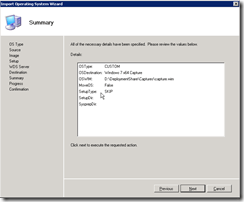The Solution Accelerators Team have released Microsoft Deployment Toolkit 2010 Update 1 Beta and would like your feedback.
Download the beta now at https://connect.microsoft.com/site14/Downloads/DownloadDetails.aspx?DownloadID=8689
MDT 2010 Update 1 provides new capabilities, such as:
· Support for Microsoft Office 2010.
· A new User-driven Installation (UDI) deployment method (formerly known as “Modena”) for Microsoft System Center Configuration Manager 2007. UDI gives information technology (IT) staff control over the deployment experience while empowering users to interact with and customize their operating system deployment through an easy-to-use wizard.
· Improvements to the Deployment Workbench driver import process, detecting each driver’s true supported platforms.
· Many bug fixes and other small improvements.
This release supports the deployment of the Windows® 7; Windows Vista®; Windows XP; Windows Server® 2008 R2; Windows Server 2008; and Windows Server 2003 operating systems. See the Microsoft Deployment Toolkit Documentation Library, which is included with MDT 2010 Update 1, for the complete documentation for this release.








































